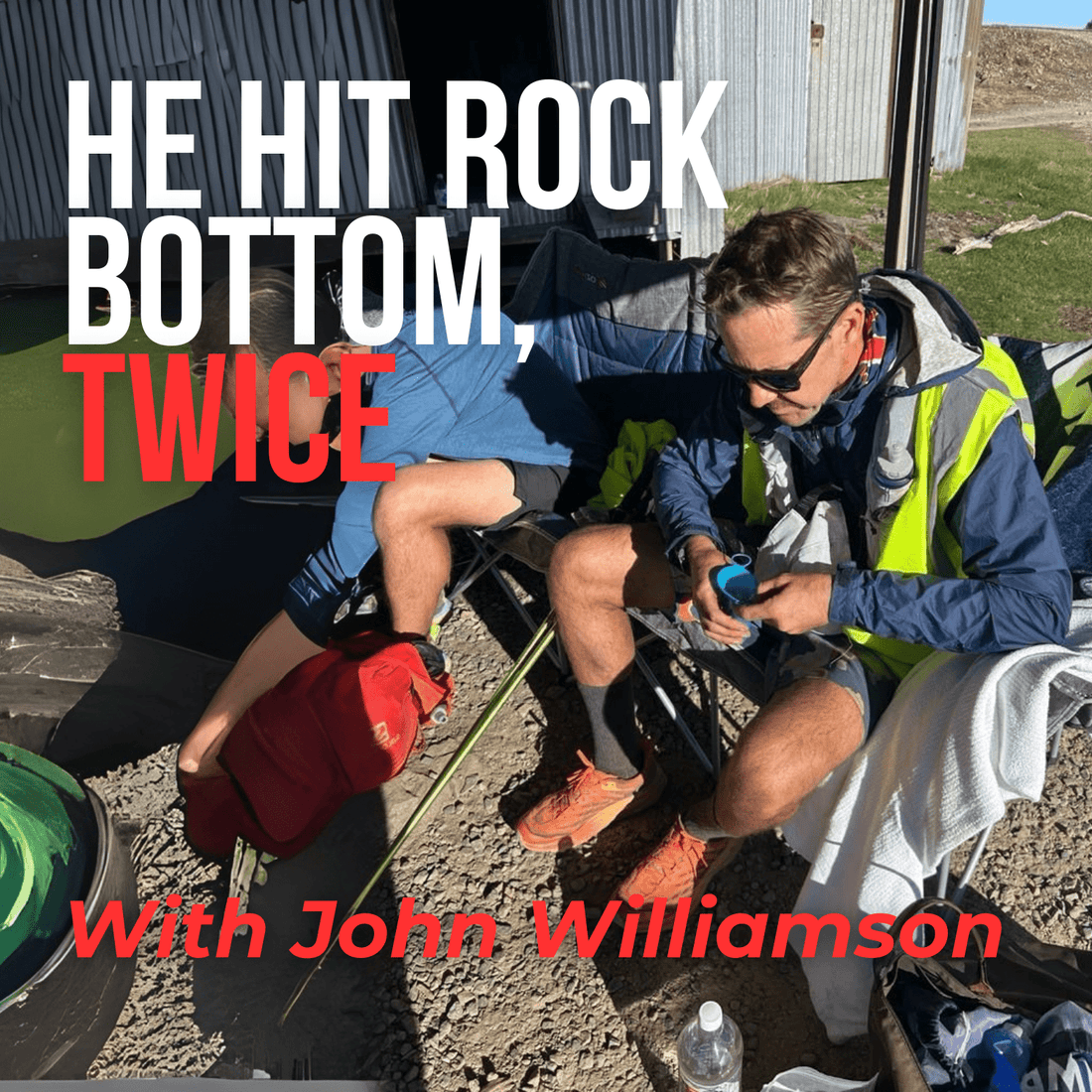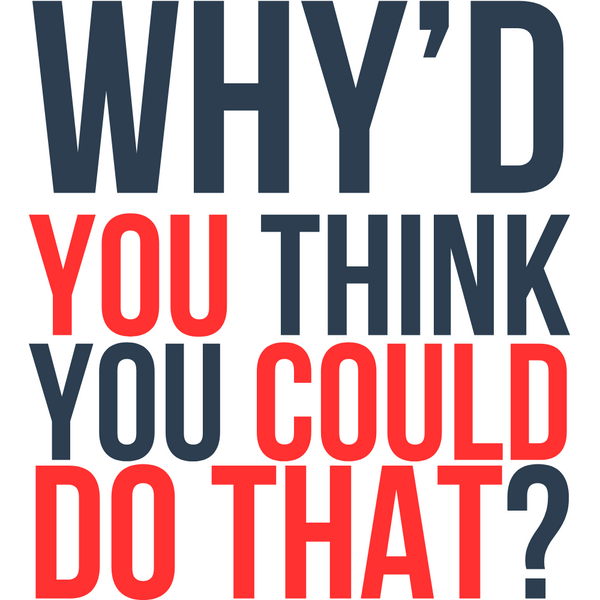
John Williamson: The Courage to Keep Turning Up
Share
When the phone buzzed on the tarmac in Brisbane, John Williamson opened his banking app and felt his stomach drop — the account was $8,000 over the overdraft with payroll due in forty-eight hours. Forty livelihoods depended on a number that didn’t add up. Most people call that rock bottom. For John, it was one of two.
This long-form feature — drawn from John’s conversation with Sam Penny on Why’d You Think You Could Do That? — explores how an ordinary Australian physiotherapist built a company during a downturn, nearly lost it twice, and rebuilt his life through discipline, endurance and the quiet courage to keep turning up.
By Sam Penny · · Read time: ~16–18 minutes
Watch the Interview



From Clinic Room to Coalface
John didn’t start with a business plan; he started with a compass. He wanted to help people heal. The early years were classic physio — treatment rooms, taping, rehab plans — until the work shifted from individual bodies to the places that broke them. A stint in Central Queensland’s mines revealed the real battleground: work design. He saw strained backs and strained systems; it wasn’t just hamstrings that needed intervention but habits, shifts and safety cultures.
That insight set him on a path that ran through Heathrow Airport, BP in London and the John Lewis flagship on Oxford Street. When a 2006 aviation security scare forced screeners to perform full squats all shift, the hidden cost of policy showed up as preventable injuries. John learned to translate physiology into productivity: fix the mechanics, and people last longer — at work and in life.
Construct Health: Building in a Downturn
Back in Brisbane in 2008, while the Global Financial Crisis taught the world to flinch, John did the opposite — he launched Construct Health. The logic was simple and stubborn: opportunity hides in contraction. The first year was slow, then slower. A business partner bowed out. John stayed, betting that when industry came back online they’d remember the guy who kept showing up during the quiet.
The bet paid off — a risky acquisition of a short-term mining contract became the wedge. Six months later it renewed at 50% larger. Growth followed another principle he’d learned at Heathrow: follow-up creates luck. A check-in with one contact who moved from mining to gas led to a lift ride that felt like a rollercoaster: in a single meeting, the company effectively doubled. Two founders walked out of the building, said nothing in the elevator, and then burst into laughter on the street. Then the real work began.
Revenue surged. EBITDA looked pretty. But receivables stretch while payroll doesn’t. It’s one of the cruellest laws in business: speed magnifies everything — including mistakes. John was about to learn that lesson the hard way.
The Elevator Moment: When Growth Outruns Cash
Growth is intoxicating. It’s also disorienting. The team hit forty, sites multiplied, and new sectors beckoned. What the P&L celebrated, the bank balance interrogated. John’s mistrust of the boom made him cautious, but not cautious enough. When the commodity cycle turned, so did the tide. Mining slowed. Gas projects sunset. Replacements arrived too slowly to matter. A prestigious program at MIT injected new ideas — and a piercing question from John to his co-founder: “Are you still in?” By the end of 2015, he wasn’t. John became the 100% shareholder and the 100% shock absorber.
What followed was a year of triage — reducing spend, consoling anxious staff, and trying to keep a culture intact while cutting costs. Then came the next mistake, born of a founder’s worst fever: deal heat. Two clinic acquisitions south-east of Brisbane looked like leverage. Post-settlement due diligence (the kind you only get once you hold the keys) told a different story. He hadn’t bought engines; he’d bought shells. The hole got deeper.
The Tarmac Call: Panic, Payroll and Pride
There are photos of leaders at ribbon-cuttings. There are fewer of leaders on airport tarmacs, staring at overdrafts. A Sunday night, a family flight, and a push notification that felt like a punch. $8,000 over. Payroll in two days. He’d never missed a payroll, and he wouldn’t start now.
Panic is physiological — racing heart, shallow breath, tunnel vision. John did what he’d started training himself to do when the pressure first spiked: breathe, move, make a plan. He juggled accounts, made hard calls, and protected the one promise he’d decided would define him as a leader: pay people on time. It sounds basic until you can’t do it. He did it anyway.
Structures That Save You: Habits, Breath and 18-Month Cashflow
When the external world becomes chaos, the internal world needs to become a schedule. John pushed his wake-up from 6:00 to 5:00 to 4:00 a.m. Not to perform on LinkedIn; to survive. He ran. He boxed. He lifted. He built a morning routine not for aesthetics but for agency — a daily practice that reminded his nervous system, “You can carry more than this.”
The practical complement to physical discipline was financial discipline. With a business coach, he built an 18-month, week-by-week cashflow that became the company’s nervous system. Every Monday it was updated; every decision ran through it. Want to hire? Model it. Want capex? Model it. Want to sleep? Model it, then act.
He added one more keystone habit: breathwork. Panic shortens breath; short breath shortens perspective. The practice lengthened both. Then he set a rule for himself and his team: name what isn’t working, spotlight what is working, and build forward from the latter while you fix the former. Progress is easier when you believe it’s possible — and evidence creates belief.
“You Can Take More Load Than That”: The Mentor Who Changed the Frame
During the worst of it, John found an unlikely mentor — a former White House Scheduling Secretary from the 1970s who went on to run large, successful businesses. The attraction wasn’t just results; it was wholeness. Here was a man in his seventies who was fit, present for his family, and useful to his community. They spoke often. John would detail another implosion-in-progress. The mentor would listen and then say a line that became a new operating system:
It wasn’t bravado; it was calibration. Once your brain believes the load is survivable, your body can carry it. The sentence became a daily prompt: one more day, one more step, one more conversation, and — critically — one more change to the plan when the plan wasn’t working.
Why He Ran 100 km and Stepped into a Boxing Ring
There’s a reason elite military units use endurance as a teacher. Environment reveals identity. John signed up for a 100 km ultra trail race after only ever racing a half marathon, not to collect a medal but to discover what lived on the other side of quitting. He found out at dusk in the Swiss Alps years later, when every cell begged him to stop and he didn’t. The day after, sore and sun-dazed at a café, he felt something precious: earned pride.
He also stepped into a boxing ring in front of a thousand people. He’d trained since 2010, always demurring when people asked if he’d fight. The business downturn stripped away the vanity and left the truth — he was scared of the ring. So he went in anyway. With a Yugoslavian former champion in his corner, he boxed clean, finished proud and walked away having reset his relationship with fear. When the next business crisis hit a month later, the afterglow of that ring helped carry him through.
Shrink to Grow: Closing Clinics and Re-setting the Game
Some turnarounds require addition. John’s needed subtraction. In 2019 he modelled scenarios and made a counter-intuitive call: close the underperforming acquired clinics and reduce the size of the business. William Thorndyke’s The Outsiders gave him language for it — great CEOs shrink when shrinking improves value.
It was humbling, public and necessary. He faced down an angry landlord with honesty: “I will pay you, just not today.” A year later the landlord rang to thank him for doing exactly that. The company stabilised. Cash buffers returned. When COVID arrived, John cut salaries, then paid back reductions the moment the trough flattened. Trust compounds faster than interest when you honour it.
Debt-Free at the Beach: The Day He Paid It All Out
By mid-2020 breathing room appeared. He considered two paths: remain independent and scale slowly, or join a national group to accelerate opportunity for the team and himself. He chose the latter and sold 80% in 2021. On a family holiday in Far North Queensland, he called the bank and paid out roughly half a million dollars in loans to create a cash-free, debt-free structure for the new entity.
Then he walked to the beach feeling something rare in grown men — uncomplicated pride. Not the swaggering kind, the quiet kind you carry in your spine. He’d taken the long way round to solvency and the scenic route to self-respect. Years later, on 4 July, he exited the final 20%. Independence Day indeed.
Col Ferret: A New Mountain to Climb
Ask ultra runners why they keep entering races and they’ll tell you: there’s always another mountain. John’s next one is called Col Ferret Holdings — named for a brutal, beautiful alpine pass on the Italian-Swiss border that he’s raced across. The theme is the family/home unit, with a thesis that branches in two: a partnered financial arm to strengthen families’ resilience and a set of patient bets in med-tech, health-tech and life sciences. The time horizon is measured in decades. This time the cashflow model will be there on day one.
The Rebuilder’s Playbook: 12 Moves You Can Use This Week
- Start with breath. Panic is a physiological loop. Break it with five slow exhales. Then think.
- Own the number. Build a rolling 18-month weekly cashflow. Monday updates, every week, no exceptions.
- Name the leak. List what’s not working and what is. Resource the latter while you repair the former.
- Protect payroll. Make it sacred. If something has to slip, don’t let it be wages.
- Move at 4 a.m. Or 6 a.m. The time doesn’t matter. The message to yourself does: “I carry load.”
- Borrow a brain. Find a mentor with wholeness, not just success. Ask for uncomfortable feedback.
- Kill deal heat. If you’re in love with the acquisition, step back a week. Re-underwrite with a skeptic.
- Shrink with pride. If closing a unit improves value, close it. Courage includes subtraction.
- Tell the truth early. To banks, landlords, staff. Most stakeholders want you to survive.
- Train for darkness. Do something hard on purpose — a long run, a cold swim, a boxing class — so stress has somewhere to go.
- Schedule the top one. Five priorities, one “must-ship” each day. 365 must-ships a year moves mountains.
- Measure pride. Keep a “kept promises” log. Evidence beats affirmations when belief runs low.
The Brave Five: Quickfire
Guilty go-to when life’s messy? A family-size bag of Natural Confectionery Company Party Mix — demolished in one sitting.
First bite after a big effort? Pain au chocolat handed to him at the finish in Chamonix — and, usually, a beer.
One-line text to 2008 John? “Do the work.”
Daily habit that keeps him sane? Ten minutes of mobility before training — small hinges swing big doors.
Best borrowed advice? “Do it now.” Tomorrow isn’t guaranteed — and “You can take more load than that.”
Listen, Subscribe & Explore the Guest Hub
Watch the full conversation above, listen on your favourite platform, and explore more quotes, resources and links on John’s Guest Hub.
